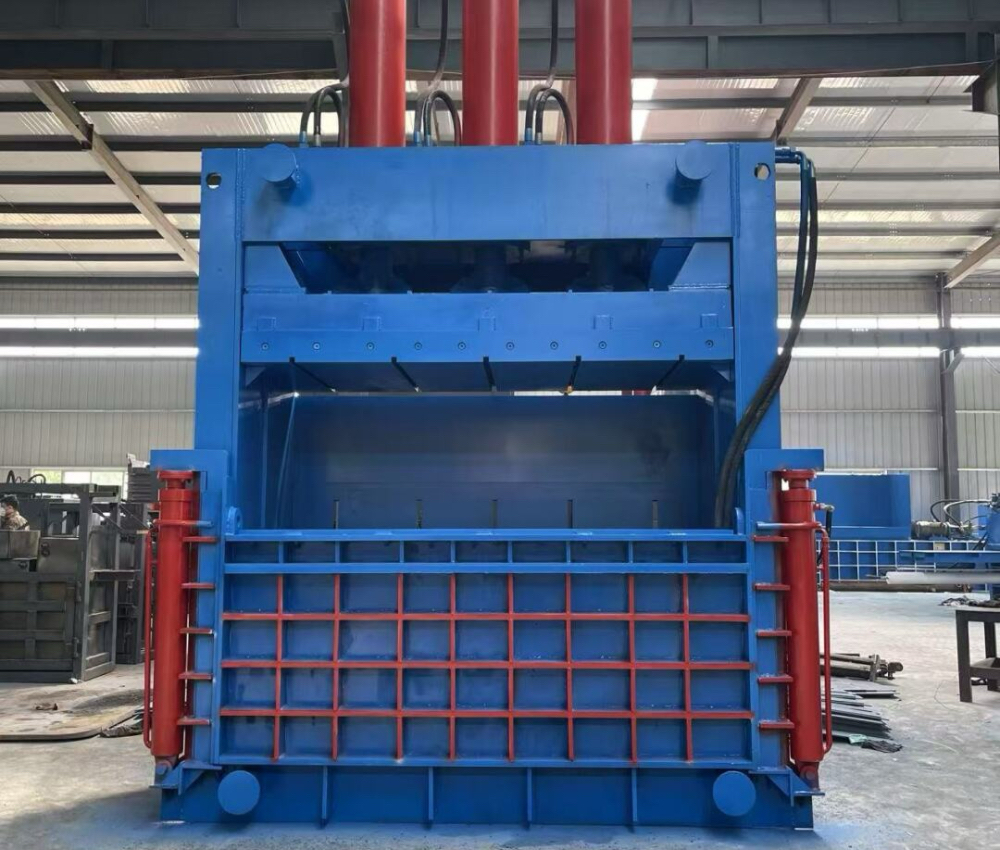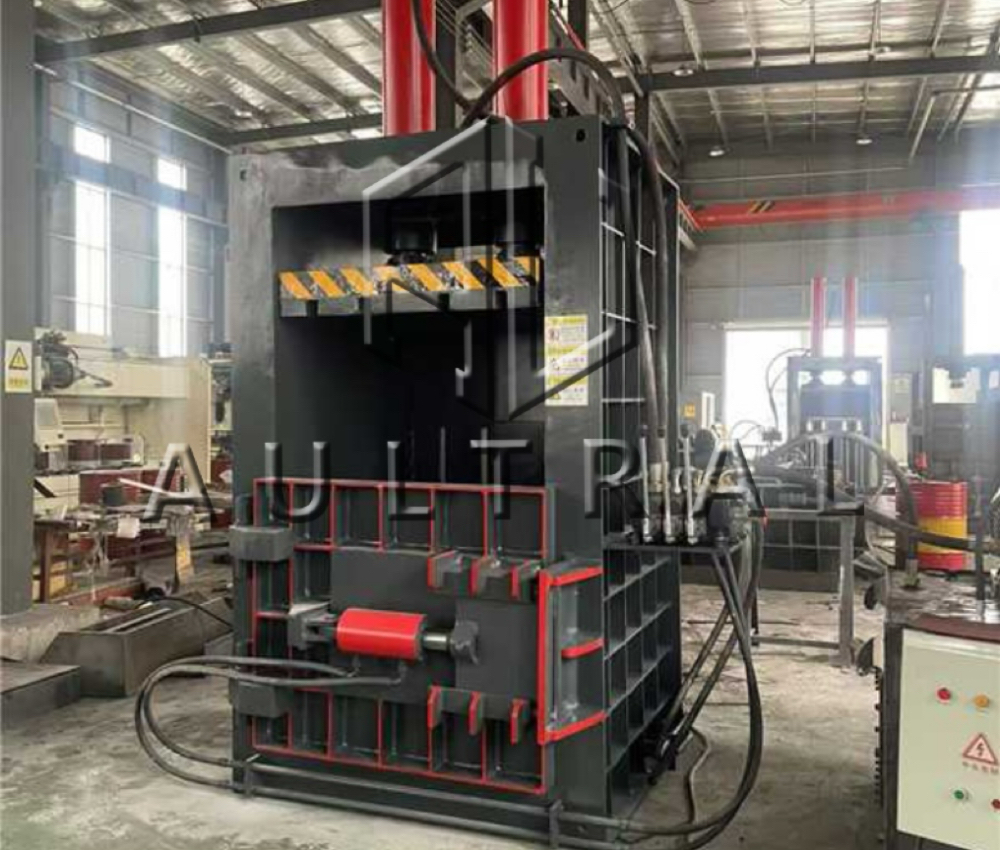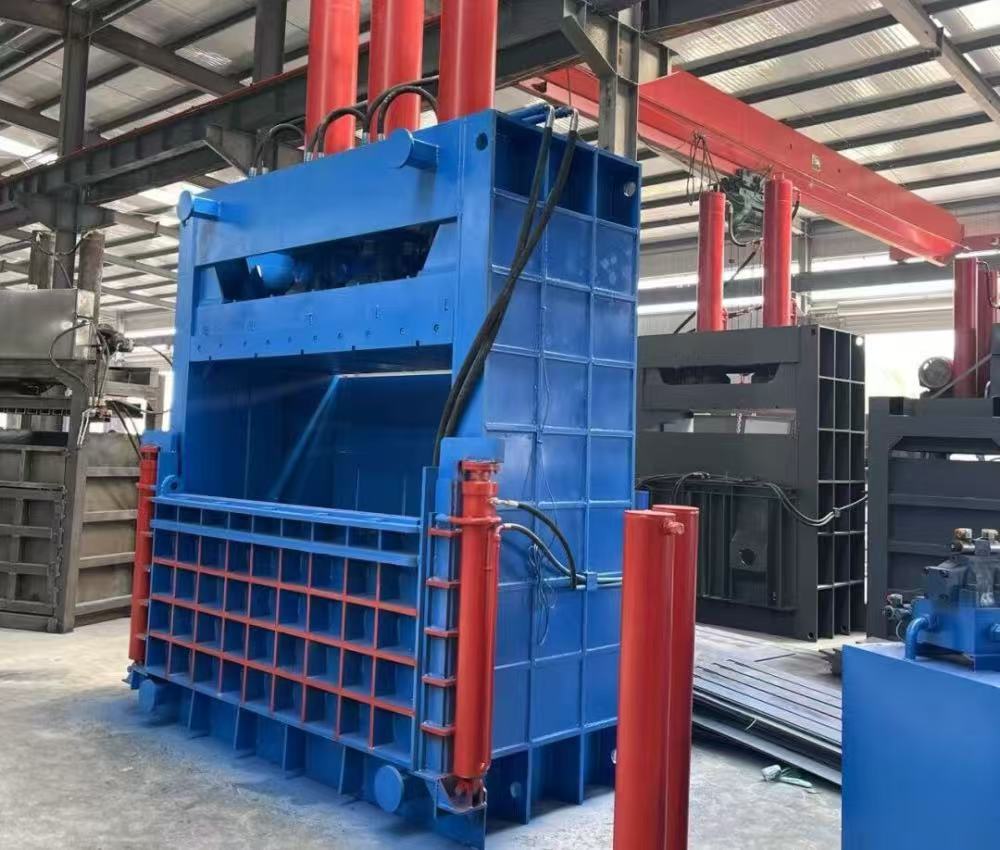Introduction
In the recycling and scrap metal processing industry, efficiency, safety, and cost control are key factors for every business. One of the most essential machines that supports these goals is the vertical metal baler machine. This equipment is widely used for compressing various types of scrap metals into dense, manageable bales.
In this blog, we will explain what a vertical metal baler is, why it is important, how it is used, and what customers should consider when choosing the right model, including pressure rating, bale size, and operational needs.
What Is A Vertical Metal Baler Machine?

A vertical metal baler is a hydraulic machine designed to compress scrap metal into compact blocks or bales. The machine applies hydraulic pressure from top to bottom, squeezing loose and bulky metal materials into a dense shape.
Unlike horizontal balers, which are generally used for high-capacity, continuous operations, vertical balers are more compact, cost-effective, and suitable for medium or small-scale recycling businesses.
Common Materials Processed
-
Aluminum sheets and cans
-
Steel scraps and tin plates
-
Copper and brass pieces
-
Used oil drums and small metal containers
-
Light metal profiles and offcuts
The end product is a compressed bale with a uniform size and weight, making it easy to transport, store, and recycle.
Why Is A Vertical Metal Baler Important?

1. Space Saving
Loose scrap metals take up large storage areas. A vertical baler reduces volume by up to 80%, maximizing warehouse space.
2. Transportation Efficiency
Compressed bales reduce shipping costs because more weight can be loaded into a container or truck.
3. Environmental Protection
By recycling metals into compact bales, businesses reduce landfill waste and promote sustainable resource management.
4. Cost Control
Handling compact bales is easier and requires fewer labor hours, lowering overall operating costs.
5. Compliance And Safety
CE and ISO9001 certified vertical balers ensure safe operation and meet international recycling standards.
How To Use A Vertical Metal Baler Machine

Operating a vertical baler is straightforward, but proper training ensures safety and efficiency. The general steps are as follows:
-
Load The Materials
Place scrap metal into the baler’s chamber. Depending on the model, the feeding can be manual or supported by a conveyor. -
Close The Door
The front door is securely locked to prevent materials from moving during compression. -
Apply Hydraulic Pressure
The operator starts the hydraulic system. The press head moves down vertically, applying high pressure to compress the materials. -
Complete Compression Cycle
The baler continues until the scrap reaches the set density. -
Tie Or Strap The Bale
Bales are bound with steel wires or straps to maintain shape. -
Remove The Bale
The compressed bale is ejected from the machine and ready for storage or transport.
Safety Considerations
-
Always ensure the door is locked before compression.
-
Do not overload the chamber beyond capacity.
-
Operators must follow safety instructions and wear protective gear.
How To Choose The Right Vertical Metal Baler
When selecting a vertical metal baler, customers should evaluate their material type, output requirements, bale size, and hydraulic pressure capacity.
1. Hydraulic Pressure Rating
The pressure capacity of a vertical metal baler usually ranges from 40 tons to 200 tons.
-
40–60 tons: Suitable for light metals like aluminum cans, tin sheets, and small scraps.
-
80–120 tons: Ideal for medium-density metals, small drums, and copper or brass scraps.
-
150–200 tons: Designed for heavier and thicker steel scraps, larger containers, and higher-density operations.
⚠️ Tip: If the material is thicker and harder, you must choose a higher tonnage to ensure proper compression.
2. Bale Size And Weight
Different industries require different bale dimensions. A typical vertical baler produces bales with dimensions such as:
-
600 × 400 × 300 mm (small bales for cans, light metals)
-
800 × 600 × 500 mm (medium bales for mixed metals)
-
1000 × 800 × 600 mm or larger (for drums, heavier scraps)
Bale weight usually ranges from 30 kg to 300 kg per bale, depending on pressure and material density.
⚠️ Tip: Customers should measure their storage and shipping requirements to select the most suitable bale size.
3. Chamber Size
The chamber should match the maximum size of the material you want to compress. For example, if you are recycling 200-liter oil drums, the chamber must be large enough to fit them without cutting.
4. Production Capacity
Consider how much scrap you process per day:
-
Small businesses: A single-cylinder 60-ton baler is sufficient.
-
Medium businesses: 80–120 ton models handle 2–5 tons per day.
-
Large operations: 150–200 ton vertical balers handle higher volumes but may also consider horizontal balers.
5. Power Requirements
Most vertical balers use pure copper motors, ensuring durability and stability. Customers should confirm whether their power supply is 220V single-phase or 380V three-phase.
Industries That Benefit From Vertical Metal Balers
-
Scrap Metal Recycling Centers
-
Manufacturing Plants (metal cutting waste)
-
Automotive Workshops (oil drums, metal parts)
-
Packaging And Beverage Companies (aluminum cans, tins)
-
Warehousing And Logistics (metal containers and returns)
Tips For Optimizing Vertical Metal Baler Performance
To ensure long-term efficiency and maximize the lifespan of your vertical metal baler, proper operation and maintenance are essential. First, always sort materials before loading. Mixing very hard metals with light metals or non-metallic waste can reduce compression efficiency and may damage the machine. For example, steel scraps should be separated from aluminum or copper to avoid uneven compression and excessive wear on the hydraulic press.
Second, do not overload the chamber. Each model has a maximum recommended capacity in terms of weight and volume. Overloading can not only strain the hydraulic system but also reduce bale density, making transportation and storage less efficient. Operators should follow the manufacturer’s guidelines for each material type.
Third, regular maintenance of the hydraulic system and mechanical components is crucial. Check hydraulic oil levels, replace filters periodically, and inspect the press cylinder and ram for wear or leaks. Lubricating moving parts and ensuring the alignment of the compression ram will keep the machine operating smoothly and safely.
Fourth, customers should pay attention to material compatibility. While most vertical metal balers can handle aluminum, steel, copper, brass, and tin, very thick steel plates or large industrial barrels may require a higher-pressure model. Matching the bale size and weight to your handling and storage capabilities ensures that the operation remains cost-effective and avoids logistical issues.
Lastly, investing in a vertical metal baler is not only about saving space and improving efficiency. Proper use of the machine can reduce labor costs, minimize scrap handling time, and increase recycling profits. Businesses that optimize bale density and size can transport more material per shipment, lowering shipping expenses and maximizing revenue.
By following these tips, operators can achieve higher compression rates, extend the machine’s service life, and enhance overall recycling efficiency, making the vertical metal baler an indispensable tool in modern scrap metal management.
Conclusion
A vertical metal baler machine is an essential investment for any business dealing with scrap metal recycling. It provides space-saving, cost-reduction, and environmental benefits while ensuring safe and efficient operations.
When selecting the right baler, customers should carefully consider hydraulic pressure rating, bale size, chamber capacity, and production needs. Choosing the correct model ensures maximum efficiency and long-term return on investment.
If you are unsure which baler best fits your operations, it is always recommended to consult with a professional manufacturer. Customized solutions can be designed to match your specific materials, output requirements, and site conditions.
At Shanghai Aultral Machinery Co., Ltd, we provide a full range of CE and ISO9001 certified balers, crushers, and shredders. Our team is ready to recommend the most suitable model for your business.
